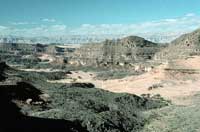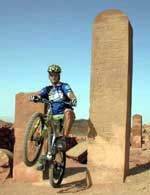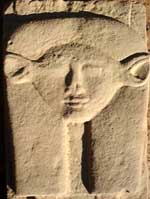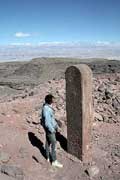|
Serabit El Khadem
 While the Egyptians seem to have known, crossed and visited the
Sinai even before the dynastic period, we have found little
evidence of their building activities in the region. Of course,
inhabitable areas are usually small, and scarce, and so have
been inhabited and built upon continuously over the ages. It is
probable that what was built has been built over many times.
Today, wondering through the Sinai and viewing its unusual
landscape, it is not difficult to imagine a land rich in
minerals. Egyptians discovered its mineral wealth very early on,
perhaps at the beginning of the dynastic period. Archaeologists
have found that the very earliest known settlers in the Sinai,
about 8,000 years ago, were miners. Drawn by the region's
abundant copper and turquoise deposits, these groups slowly
worked their way southward, hopping from one deposit to the
next. By 3500 BC, the great turquoise veins of Serabit el-Khadem
had been discovered. While the Egyptians seem to have known, crossed and visited the
Sinai even before the dynastic period, we have found little
evidence of their building activities in the region. Of course,
inhabitable areas are usually small, and scarce, and so have
been inhabited and built upon continuously over the ages. It is
probable that what was built has been built over many times.
Today, wondering through the Sinai and viewing its unusual
landscape, it is not difficult to imagine a land rich in
minerals. Egyptians discovered its mineral wealth very early on,
perhaps at the beginning of the dynastic period. Archaeologists
have found that the very earliest known settlers in the Sinai,
about 8,000 years ago, were miners. Drawn by the region's
abundant copper and turquoise deposits, these groups slowly
worked their way southward, hopping from one deposit to the
next. By 3500 BC, the great turquoise veins of Serabit el-Khadem
had been discovered.
 The ancient mining complex of Serabit el-Khadem lies on a small
plateau north of modern Al-Tor. It is located about halfway down
the western coast about ten miles from Wadi Mughara. It was one
of the most important sites for the Egyptians on the peninsula.
Today, it is not difficult to reach the Serabit el-Khadem area,
though the trip must be made by jeep. There are no paved roads
to the base of the mountain. Although many of the region's
pharaonic reliefs were destroyed by a British attempt to re-open
the mines in the mid-nineteenth century, along the path to the
temple are a number of engravings that were written by the
ancient minors. Some of the most interesting portray the ships
that would carry the turquoise to Egypt. There is also an
excellent bas relief of King Sekhemkhet on the east face of the
plateau, revealing him smiting Egypt's enemies. Other
antiquities are found along the path, including ancient tunnels,
miner's huts and stele. The ancient mining complex of Serabit el-Khadem lies on a small
plateau north of modern Al-Tor. It is located about halfway down
the western coast about ten miles from Wadi Mughara. It was one
of the most important sites for the Egyptians on the peninsula.
Today, it is not difficult to reach the Serabit el-Khadem area,
though the trip must be made by jeep. There are no paved roads
to the base of the mountain. Although many of the region's
pharaonic reliefs were destroyed by a British attempt to re-open
the mines in the mid-nineteenth century, along the path to the
temple are a number of engravings that were written by the
ancient minors. Some of the most interesting portray the ships
that would carry the turquoise to Egypt. There is also an
excellent bas relief of King Sekhemkhet on the east face of the
plateau, revealing him smiting Egypt's enemies. Other
antiquities are found along the path, including ancient tunnels,
miner's huts and stele.
 The temple at Serabit el-Khadim, though really only scattered
ruins, is one of the few phraonic monuments we know of in the
Sinai. Here it was found the famous proto-Sinaitic script",
which is believed to be an early precursor of the alphabet.
These scripts were hieroglyphic signs used to write the names of
the West Semitic names of the people who worked the mines, and
keep account of their labors. They developed an alphabet with
which they could record their Proto-Canaanite language. The
script they developed is called Proto-Sinaitric (First-Sinaitic)
and the language was a Pan-Canaanite language often called Old
Hebrew The temple at Serabit el-Khadim, though really only scattered
ruins, is one of the few phraonic monuments we know of in the
Sinai. Here it was found the famous proto-Sinaitic script",
which is believed to be an early precursor of the alphabet.
These scripts were hieroglyphic signs used to write the names of
the West Semitic names of the people who worked the mines, and
keep account of their labors. They developed an alphabet with
which they could record their Proto-Canaanite language. The
script they developed is called Proto-Sinaitric (First-Sinaitic)
and the language was a Pan-Canaanite language often called Old
Hebrew
 The Serabit El Khadim temple looks like a double series of
steles leading to an underground chapel dedicated to the Hathor
Goodness. Most of the temple’s large number of sanctuaries and
shrines were dedicated to Hathor, among her many other
attributes; she was the patron goddess of copper and turquoise
miners. It is the only temple we know of, built outside mainland
Egypt and mostly dedicated to Hathor. The earliest part of the
main rock cut Hathor Temple, which has a front court and
portico, dates to the 12th Dynasty The temple was probably
founded by Amenemhet III, during a period of time when the mines
were particularly active. The 12th Dynasty was a period of
considerable mineral wealth for Egyptians and some of the finest
jewelry from Egypt's past have been discovered in the tombs of
12th Dynasty women. The Serabit El Khadim temple looks like a double series of
steles leading to an underground chapel dedicated to the Hathor
Goodness. Most of the temple’s large number of sanctuaries and
shrines were dedicated to Hathor, among her many other
attributes; she was the patron goddess of copper and turquoise
miners. It is the only temple we know of, built outside mainland
Egypt and mostly dedicated to Hathor. The earliest part of the
main rock cut Hathor Temple, which has a front court and
portico, dates to the 12th Dynasty The temple was probably
founded by Amenemhet III, during a period of time when the mines
were particularly active. The 12th Dynasty was a period of
considerable mineral wealth for Egyptians and some of the finest
jewelry from Egypt's past have been discovered in the tombs of
12th Dynasty women.
A number of scenes portray the role of Hathor in the
transformation of the new king, upon ascending the throne, into
the deified ruler of Egypt. One scene, for example, depicts
Hathor suckling the pharaoh. Another scene from a stone tabled
depicts Hathor offering the pharaoh the Ankh.
 This older part of the temple was enlarged upon and extended by
Queen Hatshepsut, along with Tuthmosis III and Amenhotep III
during the New Kingdom. This was a restoration period for the
mining operations after an apparent decline in the area during
the Second Intermediate Period. These extensions are unusual for
a temple in the manner in which they angled to the west off of
the earlier structure. This older part of the temple was enlarged upon and extended by
Queen Hatshepsut, along with Tuthmosis III and Amenhotep III
during the New Kingdom. This was a restoration period for the
mining operations after an apparent decline in the area during
the Second Intermediate Period. These extensions are unusual for
a temple in the manner in which they angled to the west off of
the earlier structure.
On the north side of the of the temple is a shrine dedicated to
the pharaohs who were deified in this region. On one wall of the
shrine are numerous stele. A little to the south of the main
temple we also find a shrine dedicated to the god of the eastern
desert, Sopdu, which is smaller then the northern shrine.
|